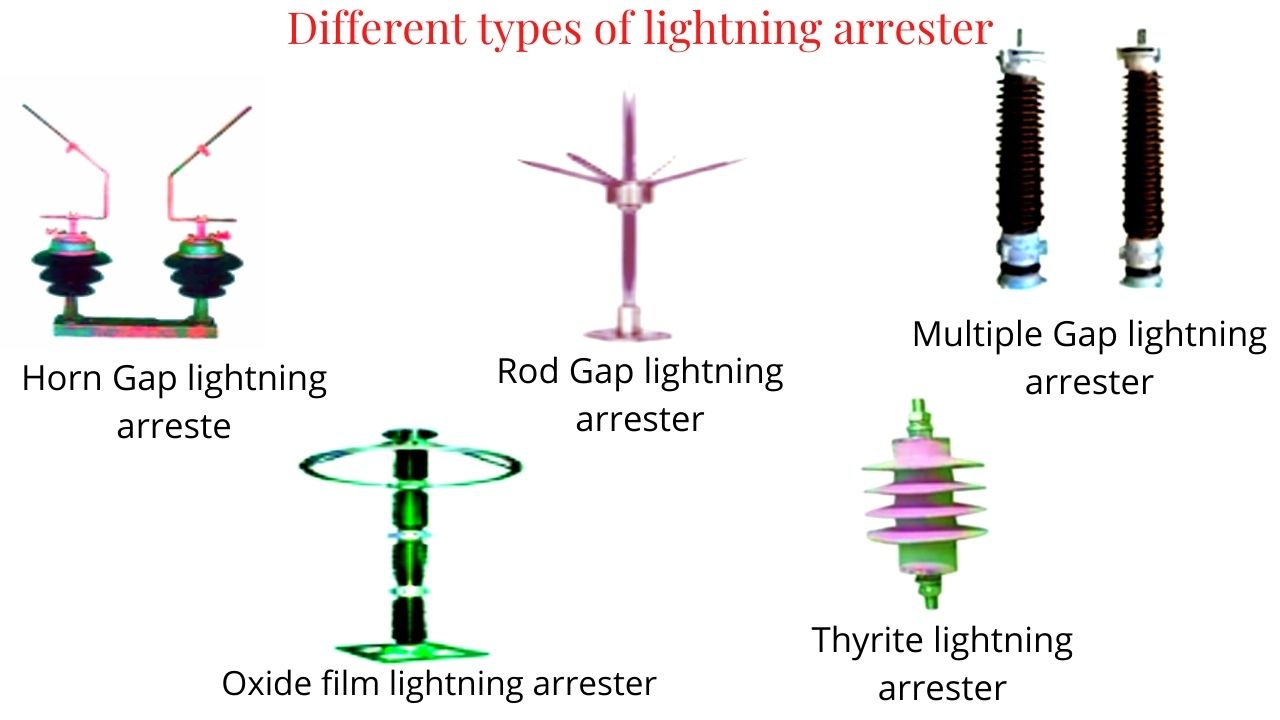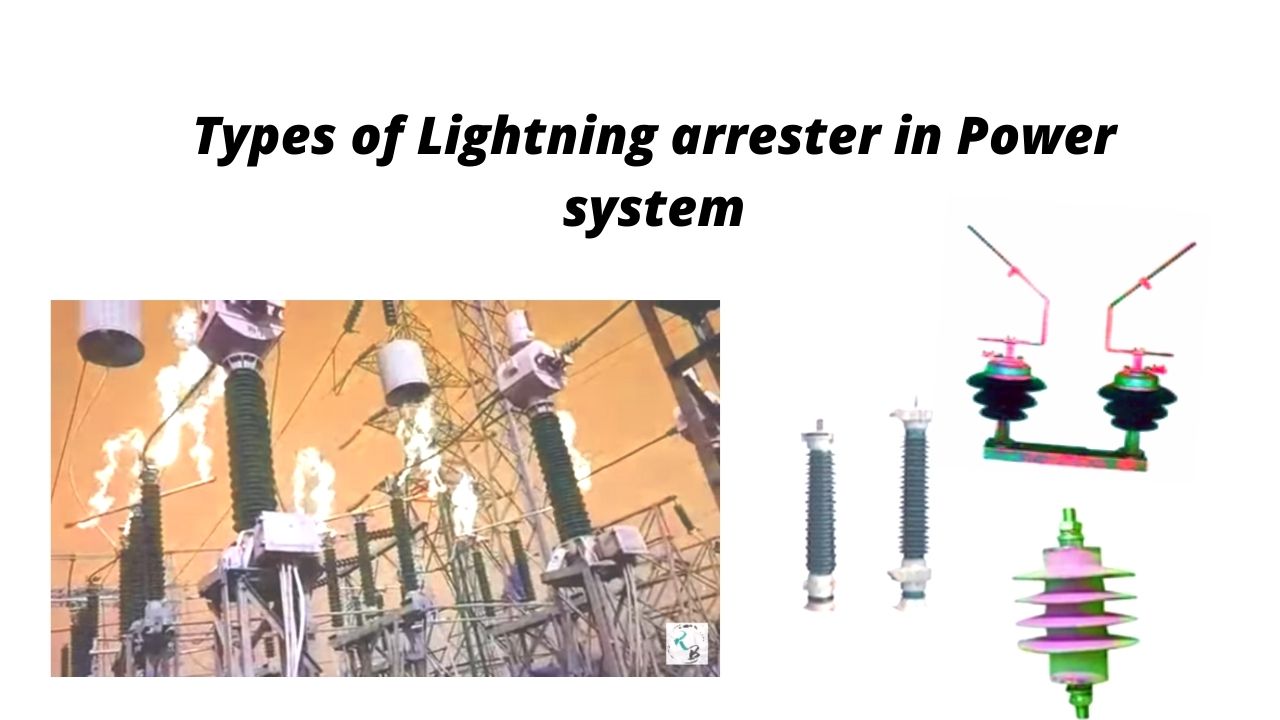Contents
What are Lighting Arresters?
Definition
A lightning arrester is an apparatus or a device which is used in electrical power systems and telecommunication system for the protection of insulation and conductors of the system from lightning strokes.
A lightning arrester is usually a device that is used to provide a path to the static electric discharge between the charged clouds and the earth. Lightning arresters typically have a high voltage terminal and a ground terminal.
As it is used for the protection of power system against high voltage surge so it is also called a Surge diverter.
Lightning is a huge spark developed due to massive electrostatic discharge taking place between the electrically charged regions within the same cloud or between a cloud and a surface of the earth.
These electrical discharges occur between or within clouds than to earth and most of them are terminated onto the earth results in serious hazards.
Requirement of Lightning Arresters
An ideal lightning arrester has the following requirements.
- Lightning arrester should not carry any current at normal system voltage. It means its breakdown voltage should be above normal or normal fundamental frequency voltage that may occur on the system.
- The transient voltage wave whose peak value is greater than the spark over voltage or breakdown voltage of the lightning arrester, its breakdown should be as fast as possible to provide a path for a surge to earth.
- After the breakdown, the lightning arrester should be capable of carrying discharge current without any damage to it, and also the voltage should not be more than the breakdown voltage.
- When the transient voltage reduces below breakdown voltage, then the power frequency current flowing through the diverter should be interrupted as quickly as possible.
Location of Lightning Arresters
Lightning arresters are generally located near the equipment to be protected because by doing this the possibilities of entering the surge in the circuit between the protective equipment and the equipment to be protected can be reduced.
Another reason is that if there is the distance between the surge diverter and the device to be protected then a steep fronted wave after being incident on the arrester, after sparks over at the appropriate sparkover voltage, enters the transformer after traveling over the lead between two and suffers reflection at the terminal.
At the terminal of the transformer total voltage is the sum of incident and reflected voltage which is approximate twice the incident voltage.
When the arrester is not placed at the correct location, the transformer may experience a surge having a magnitude twice that on the arrester.
The location of lightning arresters in a substation depends on the probability of flashover on the line per 100 km in a span of 1 year.
It will not be economical and necessary to install one surge diverter near each equipment in the substation. The best way to use an arrester is to install it at the entry of the incoming line to serve the required purpose.
Types of Lightning Arresters
Lightning arresters are mainly of the following types
- Horn Gap Arrester.
- Rod Gap Arrester.
- Oxide Film Arrester
- Multi Gap Arrester.
- Pellet Arrester.
- Thyrite Lightning Arrester.

Horn Gap Lightning Arrester
It is one of the earliest developed surge diverters and it is still in use to a certain extent on low voltage lines on account of its great simplicity.
The Horn gap arrester consists of two horn-shaped terminals of metal separated by a small air gap between them. Here the horns are so constructed that the distance between the horns gradually increases towards the top.
The horns of the arrester are mounted on porcelain insulators. Here one end of the horn is connected to the line through a resistance and choke coil while the other end is effectively grounded.
The resistance used here helps in limiting the follow current to a small value and the choke coil is designed in such a manner that it offers small reactance at normal power frequency but a very high reactance at transient frequency.
Thus the choke does not allow the transients to enter the apparatus to be protected.
The length of the air gap is directly proportional to the working voltage and it is 1.66mm for the 440v line, 10mm for the 5000v line, and 15mm for the 11000v line.
Rod Gap Lightning arrester
It is the simplest form of lightning arrester that consists of two 12 mm dia or squares with ends facing each other. One is connected to the line and the other is connected to the earth. This arrester is generally connected across the bushing of various equipment.
Rod gap lightning arresters have the advantage of low cost and it is also easily adjusted on the site.
Distance between the rod gap and the insulator should be more than 1/3 of the rod gap length to protect the insulator from the arc. Here in this arrester, the rod gap depends upon the operating voltage of the system.
There is a problem with this rod arrester is that once the spark takes place then it may continue for some time even at low supply voltage. So to overcome this problem a current limiting resistance is used in series with the arrester which limits the current to such an extent that it is sufficient to maintain the arc to the safe level.
Another problem with this arrester is that the rod gap gets affected due to the high temperature of the arc. Rod gap performance also gets affected due to variation in climatic factors.
So due to various problems with this arrester, it can’t be used for main protection in high voltage power systems where the main concern continuous supply and protection of the equipment. So it is used as a second line of protection in view of its low cost.
Oxide Film Lightning Arrester
This type of lightning arrester is made of a number of small discs with a gap in series and is connected between the line and the earth. Each disc consists of two round brass disc of size 2.5 dia and 0.5 thick fitted in between the porcelain tube.
Space between the small discs used in this arrester is filled with lead peroxide (as it has low resistance) and varnish which acts as an insulator. The operating voltage of each disc is approximately 300 volt. For any system, the number of discs required depends on the working voltage.
This arrester works on the fact that certain dry chemicals have the property to change rapidly from a good conductor to a perfect insulator when heated slightly.
So lead peroxide which has a specific resistance of 25 Ω /mm3 at normal temperature becomes a perfect insulator at about 1500c and having a specific resistance of the order 600 MΩ/mm3.
When the lightning voltage sparks over the gap, it develops a small puncture on the insulating coating and gives a path for discharge of current to the earth through the discs.
The great advantage of this arrester is that it does not require daily charging and it may thus be installed at points on transmission systems where daily attendance is difficult or expensive to provide.
Oxide film arrester is used for indoor and outdoor protection services up to 220 kV system.
Multi Gap Lightning Arrester
This arrester consists of series of metallic cylinders made up of zinc alloy generally insulated from one another and separated by a small air gap.
From the figure, we can see that metallic cylinder 1 is connected in series with the line while metallic cylinder 3 is connected to earth through a series resistance and this series resistance limits the arc.

Metallic cylinder 2 is at earth potential under normal operating conditions and it is not possible to break down the series gap by normal voltage. So in case of occurrence of overvoltage, there is a breakdown of the gap between metallic cylinders 1 and 2.
And a larger amount of current will pass through the gaps instead of choosing an alternate path through shunt resistance and will divert to earth.
When the surge is over there is no arc present in between 2 and 3, the power that follows the current is limited by the shunt and series resistances as they are now in series.
Now the current is not enough to maintain an arc in the gap between 1 and 2 and normal conditions are restored. These arresters are used for systems with line voltage up to 33 kV and are not satisfactory for the system having line voltage greater than 33kv.
In comparison to the horn arrester, the multi gap arrester has the advantage of greater sensitivity to minor voltage rises. But multi gap lightning arrester is more costly, especially for higher line voltages.
Pellet Lightning Arrester
This arrester is a modification of the oxide film lighting arrester. It consists of many small pellets or pills of lead peroxide of diameter 0.25mm.
The lead peroxide pills used in this arrester are coated with litharge powder which works as an insulating film around the pills and is placed in a porcelain tube having metal electrodes at each end.
The litharge powder film on the pellets works as a porous spacer and not function as solid insulation.
Here in this arrester when a spark occurs over the insulating film then due to high surge voltage it punctures the film and a large amount of current will discharge through the puncture film to the earth and the film again comes to its original condition after the discharge.
Pellet surge diverters are generally suitable for outdoor protection service systems of voltage up to 73 kV.
Thyrite Lightning Arrester
This arrester is generally used for the protection of equipment against high voltages. It consists of a series of spark plugs and nonlinear resister discs (which is made up of material such as thyrite, a dense inorganic compound of ceramic nature) in series and these are placed in a tight porcelain container.
During the normal conditions, normal system voltage is not sufficient to cause the breakdown of air gap assembly.
When there is an overvoltage then there is a breakdown of series, spark gap takes place and the surge current is passed to the earth through the nonlinear resisters.
This type of lightning arrester is generally used up to 240 kV transmitting system.
I hope you like this post on what are lightning arresters? For any doubt and suggestion comment below in the comment section.

Jitu Kumar is the Founder and Senior Content Head of Electrical Maker. On electricalmaker.com, we publish the latest educational updates regarding Engineering.
